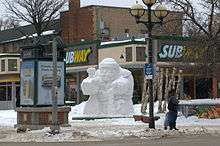Festival du Voyageur
| Festival du Voyageur | |
|---|---|
 | |
| Status | Active |
| Genre | Winter festival |
| Begins | February 17th 2017 |
| Ends | February 26th 2017 |
| Frequency | Annually |
| Location(s) | Winnipeg, Canada |
| Inaugurated | 1969 |
| Attendance | 102 000 |
| Website | |
| Festival du Voyageur | |
The Festival du Voyageur is an annual 10-day winter festival that takes place in Winnipeg, Manitoba, Canada. The event is held during each February in Winnipeg's French Quarter, Saint-Boniface, and is Western Canada's largest winter festival. It celebrates Canada's fur-trading past and unique French heritage and culture through entertainment, arts and crafts, music, exhibits, and displays.
History



The idea for a winter festival to celebrate Manitoba's Francophonie was first proposed by Georges Forest. He became the first official Voyageur. Voyageurs are people who promote the festival [1] in 1967. The proposal was put forth to the city of St. Boniface, but the city's offer was insufficient.[2]
In the summer of 1969, the mayor, Ed Turner, and the city council of Saint-Boniface granted their support under the condition that Festival became an incorporated organization. Judge Robert Trudel became the first president of Festival du/of the Voyageur. "Voyageur" refers to those who worked for a fur trading company and usually traveled by canoe. Festival du/of the Voyageur Inc. was incorporated under the Companies Act of Manitoba on December 18, 1969. It received a city grant of $35,000 but had to give back all profits up to $35,000.
At a press conference held January 13, 1970, Mayor Turner announced that the city of Saint-Boniface would present a festival honouring the Voyageur of the fur trading era, in celebration of Manitoba's centennial. The first Festival du/of the Voyageur took place February 26 to March 1, 1970, at Provencher Park, with an estimated attendance of 50,000 people. Georges Forest was in charge of promoting the event and did so by wearing clothing that represented the Voyageurs. This initiated the tradition of "Official Voyageurs," which continues to this day. The 1970 festival lasted four days and featured the walk down Provencher Boulevard, the Governor’s Bal and the Voyageur Trading Post.[2]
The large number of attendees required an unforeseen level of expenditure by festival organizers; by the festival's conclusion, the organization had a debt in excess of C$40,000. To remedy their financial situation, the organizers held horse races as a fundraiser in conjunction with the 1971 festival. The 1971 festival was a success, drawing nearly 200,000 guests. However, instead of resolving the financial situation, the fundraiser pushed the organization further into debt.
The snow sculpture that won the 1971 event was of a pair of boots and a toque. This sculpture inspired the creation of a mascot, Léo La Tuque, who was introduced in 1972 and became the trademark of Festival du Voyageur.[2]
Grants from the city of Winnipeg and the Secretary of State allowed the Festival to make arrangements with their creditors. The name was changed to "Festival du Voyageur" (the "of the" was dropped). For the 1972 festival, Arthur D'Eschambault was elected president. He hired a number of financial and management directors (most of whom were anglophone). The festival ran from February 21 to 27, and the profits amounted to C$108.46.
Two "school" voyageurs were appointed in 1977, to visit schools and teach children about the voyageurs and Festival.
In 1977, construction began on wooden log cabins in Whittier Park to accommodate the festival. The log cabins were constructed to be left there year-round. In 1978, the organization had accumulated enough surplus funds to make Whittier Park the permanent site of the festival. Provencher Park had become too small for the growing number of attendees. These cabins formed the foundation of the historic reconstruction that became known as Fort Gibraltar.[2]
In 1981, the Festival du Voyageur purchased an empty warehouse, located at 768 Taché Avenue, for administrative offices and to be used for an additional venue. The building became known as the Rendez-Vous and eventually came to include a bar named Le Canot.[2]
From February to October of 2001, a large house was constructed in Fort Gibraltar for the event. The house is called the Maison du Bourgeois.[2]
The Rendez-Vous building on Taché was put up for sale in 2003, and sold in 2006. New administrative offices were found in a building at 233 Provencher Avenue, and it came to also feature a store called the Boutique du voyageur.[2]
In 2005, a year-round interpretive centre was built in Fort Gibraltar.[2]
Current Operation
Festival du Voyageur Inc. received $438,174 in 2010 from Industry Canada's two-year Marquee Tourism Events Program (MTEP). In 2011, the festival saw 1,151 volunteers donate 14,393 hours of work.[3]
The festival currently employs 13 full-time permanent staff and at the festivals peak employs roughly 200 people.[2] The typical annual attendance is 100,000 people across all ten days of the festival.[4]
The 2013 festival saw approximate revenue of $2.9 million.[5]
See also
References
- ↑ http://www.mhs.mb.ca/docs/people/forest_g.shtml
- 1 2 3 4 5 6 7 8 9 "History of Festival du Voyageur inc.". FDV Inc. Retrieved 23 January 2014.
- ↑ Barker, John (17 February 2012). "Festival du Voyageur: Not just a celebration for Saint-Boniface". Thompson Citizen. Retrieved 23 January 2014.
- ↑ "Festival du Voyageur draws big crowds". CBC News. 20 February 2012. Retrieved 4 March 2013.
- ↑ "Festival du Voyageur Inc. 2012-2013 ANNUAL REPORT" (PDF). FDV, Inc. p. 28. Retrieved 23 January 2014.
External links
| Wikimedia Commons has media related to Festival du Voyageur. |
